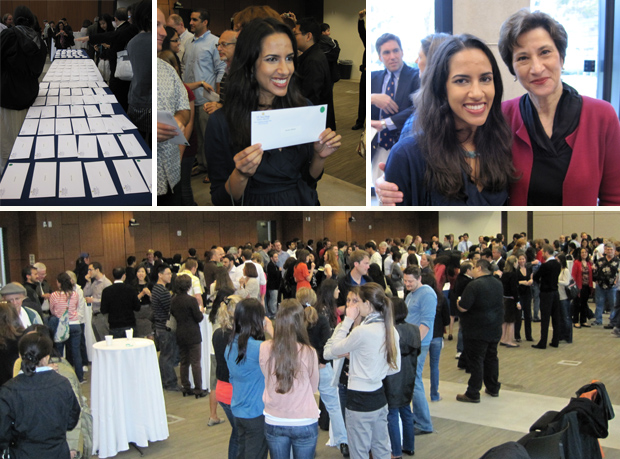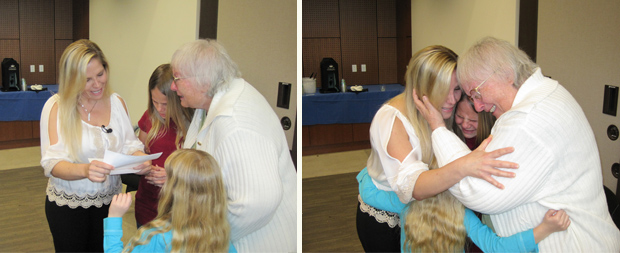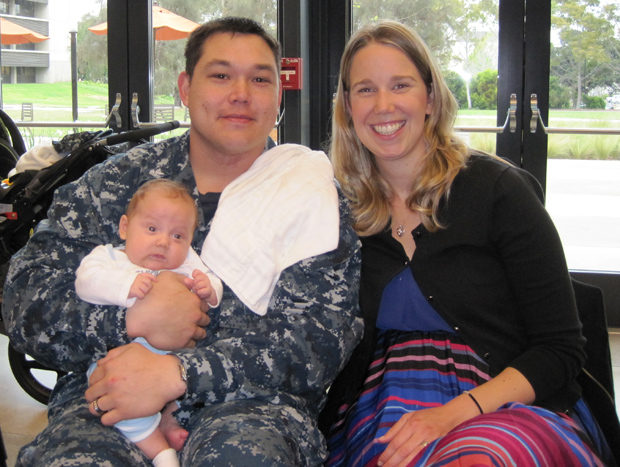
By:
- By Scott LaFee
Published Date
By:
- By Scott LaFee
Share This:
March Matchness
Medical students learn residency fate at rite of passage

Seven years ago, Melanie Aiken, 41, quit a full-time job as a middle school science teacher, sold her Apple Valley house and moved to San Diego with her three young daughters to attend the University of California, San Diego School of Medicine and, ultimately, achieve her dream of becoming a doctor.
“We gave up a lot to get here,” she said.
“Here” was the Learning Center on the ground floor of the new Medical Education and Telemedicine Center on the UC San Diego campus. It was Friday, March 16 and, most critically, it was “Match Day,” a singular time each year when graduating medical school students across the country simultaneously learn not just where they will spend the next year as residents, but also the subsequent years of specialty training that will largely determine what kind of doctor they will ultimately be.
Aiken wasn’t alone in the room, of course. With her were two of her daughters and her mother, along with the 118 fellow students in the 2012 School of Medicine class, and their families and friends – everyone waiting for the moment when the students would be told they could open the white envelopes neatly lined up on a table in the center of the room, each marked with a name and each containing a future.
Match Day, which began in 1952 and is operated by the non-profit National Resident Matching Program, culminates months of applications and interviews by the fourth-year students, each of whom may have visited a dozen or more hospitals and institutions across the country in search of their perfect match. Each student creates a ranking of their choices; each hospital and institution creates its own list of preferred students. A computer algorithm compares the lists, crunches the numbers, generates millions of possible combinations and, finally, produces a single choice for each matched student.
(Some students don’t get matched, leading to the “scramble,” a brief period in which they frantically apply for unfilled residency positions.)

“Every doctor remembers Match Day,” said Dr. Maria Savoia, dean of medical education in the School of Medicine, with a clinical practice with the Infectious Disease Division of the UC San Diego Department of Medicine. “You think about this day working through the years of medical school. And I will tell you that however it turns out, wherever you go, it will be for the best. You will meet wonderful patients. You will learn a lot. And you will have wonderful careers.”
Varied careers too.
Justin Voog, a 31-year-old dual M.D.-Ph.D. student at UC San Diego, wants to pursue a career in academic research, specifically in radiation oncology. Standing beside a map with pins indicating all of the places previous UC San Diego medical students have gone, he says he’s hoping for a spot in California or the northeast.
Anshu Abhat, 26, has been at UC San Diego for eight years, first as an undergraduate and now as a medical school graduate. Her interests are in health disparities. She wants to both treat the medically underserved and help influence the broader policies impacting them. She’s applied to institutions nationwide, but hopes to stay on the West Coast, close to family and friends.
Kristen Wigby has spent years following her husband Eric’s naval career as a submarine nuclear technician. Now, as they sit waiting for envelope time, he’s preparing to follow her medical career (he’ll be discharged soon), along with their 2-month-old son, Zeke. Wigby wants to be a pediatrician. She’s hoping for a residency in either San Diego or Colorado.
Savoia informs the students that 25 percent of them have matched for programs at UC San Diego, for part or all of their training; 70 percent of the students will remain in California. It’s a key point, she says, and not just because they’ll be closer to home, family and friends. “It’s important because part of our mission is to produce new generations of doctors for California.”
At exactly 9 a.m., the students are told they can open their envelopes. There’s a rush to the table, a soundburst of ripping paper and then a crescendo of cheers, tears, laughter and exultation as destinies are discovered.

The Wigbys
Voog will spend his one-year residency at Scripps Mercy before moving onto the radiation oncology program at Brigham and Women’s Hospital in Boston. He’s thrilled, but no more so than his girlfriend, Jennifer, a 5th-grade school teacher who says they’ll now have a year to prepare for East Coast winters.
Abhat is bound for the University of Washington, one of her top choices. It’s farther from her family, “but I have friends who have gone there. They have families there. I’ll get them to adopt me.”
Wigby, with her husband and young son, are headed for Colorado.
Aiken, the 41-year-old mother of three, grabs her envelope and moves off to a corner of the crowded, noisy room. Her mother and daughters gather around, their expressions fraught with anxiety and hope. Hands trembling, Aiken peels opens the envelope and quickly reads the single page. She’s staying at UC San Diego, not just for her year of residency, but for the following four years as well.
Eyes tearing, Aiken pulls her children and mother toward her. “We’re staying. We don’t have to pick up and move again,” she cries. Everybody is crying. It’s a huge moment of relief, joy and expectation.
“This was my first choice,” she says. “The doctors and the School of Medicine took a big chance on me. I’m grateful to all of them for believing I could do this. I’m going to work so hard for the next four years. I’m going to be a very good doctor.”
Everyone believes her.
Share This:
You May Also Like
Stay in the Know
Keep up with all the latest from UC San Diego. Subscribe to the newsletter today.


